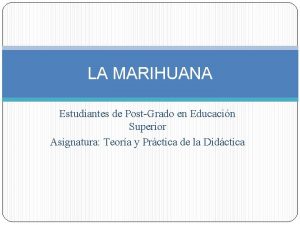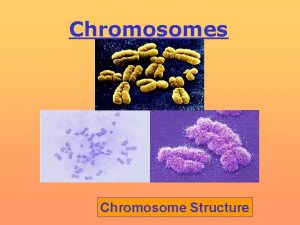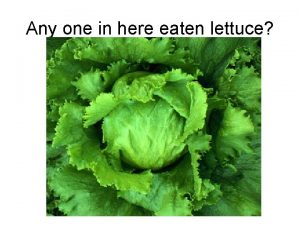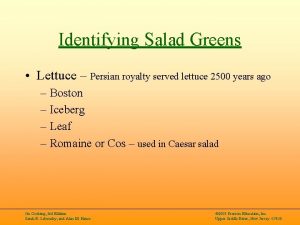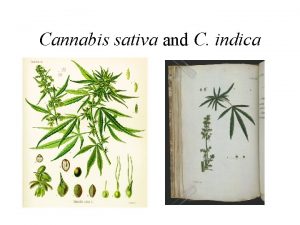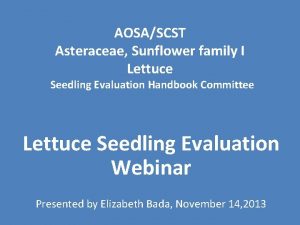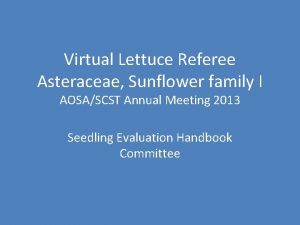LETTUCE Lactuca sativa LettuceLactuca sativa Family Chromosome No













- Slides: 13

LETTUCE (Lactuca sativa)

Lettuce(Lactuca sativa) Family Chromosome No. Origin : Compositae : 2 n=16, 18 : European-Siberian Ø Most important salad crop Ø Occupy maximum area under salad vegetables. Ø Temperate vegetable but also grown in tropical and subtropical climates of the world Ø Tender leaves and heads are consumed as salad after chopping Ø Rich in vitamin A, Ca and Fe.

Types of Lettuce 1. Head type (L. sativa var. capitata) I. Butter head type: Ø Produces relatively small & loose heads. Ø The outer leaves are green in colour Ø Inner leaves are creamy or yellow which are oily, crumpled & soft texture. Ø They do not withstand shipping and handling. II. Crisp head type: Ø Popular in North America & European countries Ø Brittle textured a tightly folded large heads (upto 1 kg). Ø Excellent shipping & handling abilities. Ø Leaves are wrinkled, non-wrapped and round. Ø The outer leaves are green and inner leaves are very thin, crisp & soft.

2. Leafy or bunching type (L. sativa var. crispa) Ø Non-heading type. Ø Colour of leaves varies from light green to red. 3. Cos or romain type (L. sativa var. longifolia) Ø Plants are straight growing and about 25 cm in height Ø Produces elongated leaves to form a loaf shaped head. Ø The outer leaves are slimy & light green coloured Ø Inner leaves are finer & light in colour. Ø Coarse leaves with good eating quality.

4. Asparagus or stem type (L. sativa var. asparaginia) Ø Also known as celery lettuce. Ø Produces thick stems which are consumed either raw or cooked as vegetable after peeling. Ø The leaves are also edible but inferior in quality than other types. Mixture of different types of lettuce

Varieties White Boston : Dark green : Green lakes : Great Lake, Imperial 859 : Slobolt, Chinese Yellow : PH-Lettuce : Butter head type Crisp head type Leafy type Stem type For H. P. Alamo 1 Simpson Black Seeded Eves Wonder Ruby : Head type. : Leafy type. : Heading type. : Leafy &purple

Climate Ø Cool season vegetable. Ø Requires a monthly average temperature of 12 -15 o. C. Ø Seeds become dormant & fail to germinate when the soil temperature is above 22 -30 o. C. Ø Temperature above 22 o. C promotes bolting causing bitterness in leaves & accelerate the development of tip burn and rot. Ø Hot, rainy or humid weather is also not favourable as it causes rotting of head lettuce. Soil Ø Thrives best on well drained sandy loam soil rich in organic matter. Ø Sensitive to high acidity. Ø p. H 5. 8 -6. 6 Ø About 2 -3 ploughings followed by planking is essential to get the soil friable and leveled.

Seed rate 400 -500 g/ha Leafy type is sown directly in the field Spacing 45 x 30 cm Planting time N. I. Plains: Low hills : Mid hills : High hills: September-October of nursery September-November September-October March-July

Manures & Fertilizers FYM (q/ha) N 100 60 P 2 O 5 (Kg/ha) 40 K 2 O 40 Method of application same as other leafy vegetables Irrigation v Immediately after transplanting v Subsequently, irrigate the crop at an interval of 8 -12 days.

Interculture & weed control ☻ Shallow hoeing & weeding are essential to keep the field free from weeds & to maintain proper aeration. ☻ About 3 -4 hand weedings at 15 -21 days interval are sufficient. ☻ Pre-transplant application of Fluchloralin @ 1. 0 -1. 5 kg/ha effectively controls most of the weed.

Harvesting ☼The leafy var. become ready for harvesting within 5060 days of sowing ☼Harvest when the leaves attain full size but remain tender. ☼Head type var. takes 60 -70 days to harvest. ☼Heads are harvested when they attain a good size & become solid. Yield Head type: 100 -140 q/ha Seed production Isolation distance: 25 m

PHYSIOLOGICAL DISORDER Tip burn Big vein Tip burning of the lateral margins of the inner leaves of mature heads. Reasons: © High temperature, light intensity & long duration © Excess N © Ca & B deficiencies. © High Mn content. Management: © Spray the crop with Ca. Cl 2 @ 0. 5% DISEASES Damping off, Root rot, Downy mildew, Bacterial rot, Lettuce mocaic, Big vein (soil borne viruses), fungus Olpidium INSECTS Aphids: Spray oxydemeton methy@0. 025% or malathion@ 0. 05%

 Familia
Familia Sativa originaria de las cordilleras del himalaya
Sativa originaria de las cordilleras del himalaya Cabanis sativa
Cabanis sativa Prokaryotic chromosome vs eukaryotic chromosome structure
Prokaryotic chromosome vs eukaryotic chromosome structure Crichex
Crichex Lettuce
Lettuce Let’s get ______ lettuce
Let’s get ______ lettuce Kind is countable or uncountable
Kind is countable or uncountable Lettuce anyone
Lettuce anyone Romaine lettuce growing stages
Romaine lettuce growing stages Lettuce
Lettuce Anger countable or uncountable
Anger countable or uncountable Vegetables počitatelné
Vegetables počitatelné Amoebas
Amoebas

